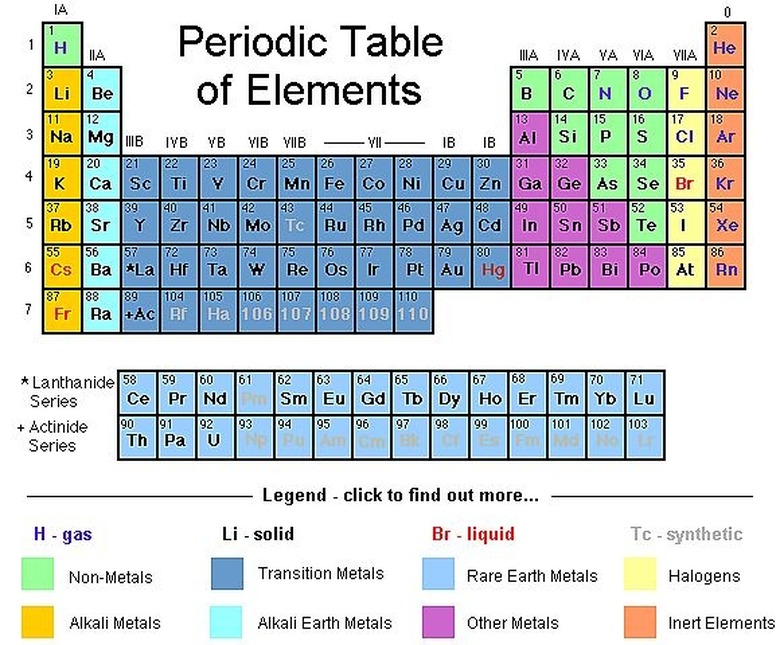How To Use The Periodic Table
Most people who are not familiar with chemistry don't have a good understanding of the periodic table of elements. It's is amazing to know how each and everyone of the elements has a role is our lives. A simple molecule like water can be understood by looking at and using the periodic table.
Step 1
The layout of the periodic table is very important to its understanding. It was laid out so that the elements go in order by atomic number. The atomic number is the number of protons and electrons in a neutral atom. Hydrogen, the first element on the table, has an atomic number of one. In order for this element to be neutral it must have one proton(+) and one electron(-). Another example is oxygen. Oxygen has an atomic number of 8. This means that it has 8 total protons(+) and 8 total electrons(-). As we move across and down the periodic table, we add protons and electrons.
Step 2
Now that you understand what the atomic number is, let's look at how the electrons in an element are arranged. Electrons are arranged by orbitals. Orbitals are an electrons "home". Think of the orbitals as an apartment building. The first floor has the lowest energy and is the s-orbital. The second floor has a bit more energy and are the p-orbitals. The third floor has even more energy and are the d-orbitals, so on and so on.
Step 3
Electrons are arranged so that they will enter an orbital by lowest energy first. For example, Oxygen which has 8 electrons, will have two in its 1S orbital, two in its 2S orbital, and four in its 2P orbitals (x,y,z). The thing about electrons is they HATE to be paired up in the same orbital. Since there is a total of six possible locations in the 2P orbital(2 in x, 2 in y, and 2 in z) and only four electrons, two of them will be unpaired. These unpaired electrons are what are used to "bond" with other elements. They are called valance electrons.
Step 4
To understand how electrons bond together let's take a look at water(H2O). By looking at the periodic table we see that Hydrogen has an atomic number of one. This means that it has one electron in its 1S orbital. Now because this electron is unpaired, it can be used for bonding. Oxygen we know from step 3 has 2 unpaired electrons for bonding. Water consists of 2 elements of hydrogen and one element of oxygen. This means that we can make a "hybrid" by taking the two electrons from the hydrogen's and bonding them with the two electrons from the oxygen. By doing this we eliminate any free electrons and the molecule is now stable.
Step 5
Now that you know how to bond together simple elements, let's look at the concept of electronegativity(i will use e-neg for short). E-neg is a measure of how electronegative an element is. In other words, it's a measure of how much an element likes to pull electrons toward itself. E-neg increases up and to the right on the periodic table. Fluorine is the most electronegative element and tends to pull all electrons toward itself. This concept is what makes hydrogen fluoride(HF) such a strong acid. The one lonely electron on hydrogen is being pulled toward fluorine so much that hydrogen can be remove by another element very quickly. The easier it is to remove a hydrogen from a molecule, the more acidic it will be.
Step 6
Whenever you have a chance, sit down and try to draw the orbitals for each element and see how many unpaired electrons to come up with. If you can master the periodic table, you can master chemistry!
Things Needed
- Periodic table
- Chemistry know-how
TL;DR (Too Long; Didn't Read)
This article was meant to be a quick explanation. You will need to read about orbitals and acids to get a better understanding.
Cite This Article
MLA
Contributor, . "How To Use The Periodic Table" sciencing.com, https://www.sciencing.com/use-periodic-table-4598879/. 24 April 2017.
APA
Contributor, . (2017, April 24). How To Use The Periodic Table. sciencing.com. Retrieved from https://www.sciencing.com/use-periodic-table-4598879/
Chicago
Contributor, . How To Use The Periodic Table last modified August 30, 2022. https://www.sciencing.com/use-periodic-table-4598879/
